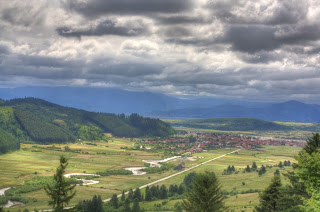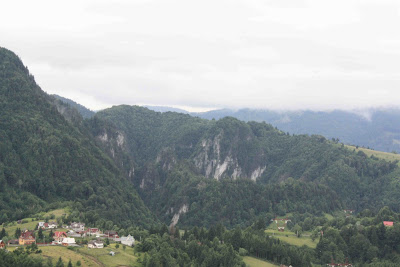Since my post this morning about the three earthquakes in the Ukraine side of the Black Sea, one more happened today at 16:10:56 (UTC).
Here is the map with all four events:
I also found a tectonic map with the major fault zones at the end Jurassic (after Robinson et al, 1997), that may shed some light regarding the seismicity in the Black Sea. It appears that the lone event is related to a fault zone bounding the Shatsky Ridge in the eastern Black Sea, and the three clustered ones SW of Sevastopol are near the Jurassic tectonic boundary of the Tavrik-Kure basin.
Low magnitude earthquakes are not uncommon in the Black Sea. Below is a list of all the 2010 seismic events with a magnitude greater than 2 on the Richter scale (from the National Institute of Earth Physics, Romania):
Sunday, July 25, 2010
Black Sea Earthquakes
On Saturday, three earthquakes in the Black Sea succeeded over an interval of five minutes.
The first was located west of Sevastopol and occurred at 18:51 (UTC).
The second took place SE of Sevastopol at 18:55:24 (UTC).
The third earthquake was located very close to the first, about 64km W of Sevastopol, and occurred at 18:55:52 (UTC). The four maps above are courtesy of the National Institute for Earth Physics in Romania.
I do not know much about the earthquakes in the Black Sea, since the big events in Romania are related to the Vrancea region (see my previous post here on the geology and wine - seismic terroir). I will try to find out more about the focal mechanism and other information, but if any of you know more, please leave comments.
From information I found on EarthquakeDB, in 103 A.D an earthquake in Ukraine (map below) associated with a Tsunami had the epicenter located very close to the ones that occurred yesterday. Fortunately, no Tsunami on Saturday!
Labels:
Black Sea,
earthquake
Saturday, July 24, 2010
Trip to the past
I recently returned from a trip to Romania, in Zarnesti-Bran-Piatra Craiului area; this was a trip to the past in a couple of ways: my past, and the geologic past.
Twenty-some years ago I was an aspiring geologist, and while I was waiting to find out if I made it into the Geological Sciences School at the University of Bucharest, I went with a group of friends on the week-long trip to the Piatra Craiului Mountains. We had a great time and I have great memories, so this year I decided to retrace some of my steps of many years ago.
We accessed the trails from our home-base in Zarnesti, you can see the town in the distance in this picture. I took it from the hiking trail leading to Curmatura cabin, the placed my friends and I used as our base camp on our vacation from the past. The picture is looking towards ESE, and in it you can also see the Barsa Mare River and, in the distance, the Southern Carpathians.
Piatra Craiului is a spectacular mountain range, its crest is about 25 km long (Google map in my previous post), and it owes its beauty to geology.
And here comes the trip to the geologic past. The mountains consist primarily of Jurassic and Cretaceous limestone, with the entire section about 1050 m thick. The lower 500m consist of a carbonate breccia and conglomerate sourced from Late Jurassic reefs located to the south, in the area of today's Bucegi Mountains. The rest of the section consists of reef carbonates and these are the rocks that give the area its beauty. The picture above shows the western versant of the Piatra Craiului and is taken from the Plaiul Foii Chalet , the place where we will stay for sure on our next trip here.
The mountains are a dream for spelunking, rock climbing, hiking, or just hanging out. Dambovicioara Gorge (shown in the picture to the left), a 2 km spectacular narrow, v-shaped canyon with steep sides, is another attraction.
We returned home from the trip to the past driving through the Rucar-Bran corridor. It was a rainy day, with heavy fog at times, which made the picture taking not an easy task, but the image below gives a good idea of the natural beauty of the area.
Piatra Craiului became a National Park in 1938; a nice post about the park, with info and pictures, came out recently in the True Romania blog here.
Twenty-some years ago I was an aspiring geologist, and while I was waiting to find out if I made it into the Geological Sciences School at the University of Bucharest, I went with a group of friends on the week-long trip to the Piatra Craiului Mountains. We had a great time and I have great memories, so this year I decided to retrace some of my steps of many years ago.
 |
| © RomaniaRocks |
Piatra Craiului is a spectacular mountain range, its crest is about 25 km long (Google map in my previous post), and it owes its beauty to geology.
 |
| © RomaniaRocks |
 |
| © RomaniaRocks |
We returned home from the trip to the past driving through the Rucar-Bran corridor. It was a rainy day, with heavy fog at times, which made the picture taking not an easy task, but the image below gives a good idea of the natural beauty of the area.
Piatra Craiului became a National Park in 1938; a nice post about the park, with info and pictures, came out recently in the True Romania blog here.
 |
| © RomaniaRocks |
Labels:
Piatra Craiului,
Romania
Subscribe to:
Posts (Atom)









